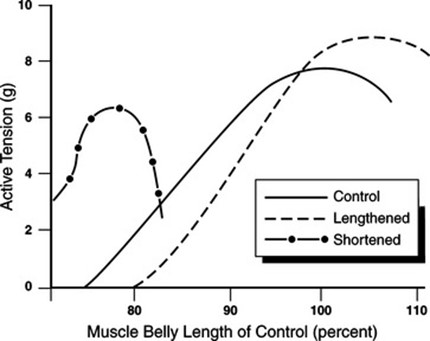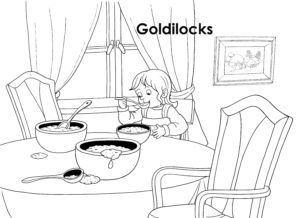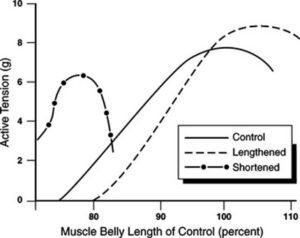Muscle “stretch weakness” – How does the length of a muscle affect its ability to generate force/tension?

As a muscle contracts and shortens it can generate a greater amount of force/tension. However, as the length of the muscle becomes shortened or slack or lengthened or too long the muscle loses its ability to generate tension/force.
The relationship between muscle length relative to a muscle’s ability to generate tension/force follows the Goldilocks principle.

The range of motion of a joint determines the length of the muscle that is moving the joint. Muscles can generate greater tension/force strength when the muscle is neither too long (stretched) nor too short (slack).

The goldilocks principle, the muscle is strongest at the resting length, not stretched, not slackened, just right.
What causes muscle stretch weakness?
There are different mechanisms that result in a muscle becoming too long.
Prolonged stretching of muscle from immobilization casting; injurious strain or sustained stretching from habitual postures or positions can result in adaptive lengthening of the muscle. Medical conditions that can influence the length of a muscle include sustained stretch from obesity, hormonal influences, and genetic conditions.
When comparing the strength of a relatively lengthened muscle to the strength of a normal-length muscle there is a difference.

(Modified from Gossman, Sahrmann SA, Rose SJ: Review of length-associated changes in muscle. Experimental evidence and clinical implications, Phys Therapy 62(12):1799, 1982.)
The lengthened muscle (dotted line) develops greater tension (force) at a longer length relative to the normal-length muscle (solid line). The same lengthened muscle when tested in a shortened position (slack position) develops less tension (force) than the normal-length muscle (solid line).
This is commonly called “stretch weakness” or “muscle active insufficiency” or “length-associated muscle weakness.”
Muscle active insufficiency occurs if a muscle that crosses two or more joints produces simultaneous movement at all the joints that it crosses, it soon reaches a length at which it can no longer generate a useful amount of force. Under these conditions, the muscle is understood to be actively insufficient.
Table: describing the lower extremity muscles positions of muscle active insufficiency & synergistic one joint muscles & potential injuries
| Two joint muscles which can be actively insufficient | Joint position of active insufficiency – position of the muscle’s shortest length – slack position | Underlying synergistic one-joint muscle | Potential problems |
| Intrinsic plantar flexor muscles of the foot (flexor digitorum brevis, abductor hallicus brevis, abductor digiti quinti) | Plantar flexion of midtarsal joint, plantar flexion of 1st metatarsal phalangeal joint (MTPJ) | Interossei, lumbricals | Plantar heel pain syndrome, hallux valgus, Morten’s neuroma |
| Extrinsic plantar flexor muscles of the foot (flexor hallicus longus, flexor digitorum longus) | Ankle plantar flexion, midtarsal joint plantar flexion, MTPJ plantar flexion | Intrinsic plantar flexor muscles of the foot, AHB, FDB, abductor digiti quinti | Plantar heel pain syndrome, hallux valgus, Morten’s neuroma |
| Ankle plantar flexor muscles (gastrocnemius soleus, FHL, FDL) | Knee flexion ankle plantar flexion | Soleus, posterior tibialus, plantaris | Achilles tendinopathy, posterior tibial tendinopathy, shin splints |
| Hamstring muscles (semi membranous, semitendinosus, superficial gluteus max) | Hip extension, knee flexion | Popliteus, a portion of the biceps femoris attaches to the femur | Hamstring tendinopathy |
| Hip abduction muscles lateral rotation (superficial gluteus max, tensor fascia latea | Hip abduction, extension, lateral rotation of the femur | Gluteus Medius, piriformis | Gluteal tendinopathy, piriformis syndrome |
| Rectus femoris | Hip flexion, knee extension | Iliopsoases | Patellar femoral arthralgia |
Illustrations of the joint positions of muscle active insufficiency are available in previous blog.
How to determine if there is a stretch weakness
The examiner positions the joint at the completion of the end of the range of motion. A position when the muscle is at its shortest length – see table above 2nd column. Then the examiner instructs the client “When I let go hold this position, don’t let it drop”. If the client is unable to maintain the test position, there is weakness at the end of the range of motion, stretch weakness.
Why is it important to know if a muscle exhibit stretch weakness or is actively insufficient?
- Having a muscle that can generate sufficient force/tension at the extremes of the range of motion can contribute stability of the joint. If a muscle has stretch weakness or is actively insufficient it has difficulty generating force/tension at the extremes of the range of motion. The joint is less stable. There is a greater risk of injury.
- I postulate that two joint muscles with active insufficiency are a contributing factor in exercise-induced muscle cramping.
Altering stretch weakness, muscle active insufficiency, length associated muscle weakness.
Knowing that a muscle is not strong enough to complete the full range of motion provides direction on how to design and focus strengthening exercises.
When performing strengthening exercises muscle active insufficiency provides an opportunity to inhibit the influence of the two joint muscles while potentially promoting the influence of the synergistic one joint muscle.
Competitive Bodybuilders’ concerns are with developing the size and shape of muscles. They frequently use the concept of muscle active insufficiency to “target” or “isolate” the exercise to develop specific muscles.
It is important to realize, though, that strict isolation of a muscle is impossible. There simply is no way to fully isolate one muscle without involving other synergists in the activity. Using muscle active insufficiency may proportionally engage the one-joint muscle more than the two-joint muscle.
Performing strengthening exercises when the muscle is in a position of active insufficiency can improve that two joint muscle’s ability to contract and perform in the slack position. The colloquial saying “Drink the hair of the dog that bit you” applies. Meaning the best cure for what ails you is to have some more of it. If you are weak at the end of the range of motion perform resistive strengthening exercises at the end of the range of motion.

End-range isometric strengthening refers to the exertion of force when a muscle is at its shortest length (slack position). Identifying the weakest point in the range of motion than using a partial range of motion repetitions at the end of the range of motion can facilitate altering stretch weakness.
Performing strengthening exercises at the weakest point in the range of motion is an application of bodybuilders' concept of targeted or isolation training.
For muscles that are too long or experiencing stretch weakness to effectively complete the range of motion at the end of the range may require some assistance. Such as using a hand to lift a joint to complete the full range of motion.
A Physical Therapist can identify ways to aid in achieving the complete range of motion including the end range position.
The information on this website is not intended or implied to be a substitute for professional medical advice, diagnosis, or treatment. You are encouraged to perform additional research regarding any information contained available through this website with other sources and consult with your physician.
Damien Howell Physical Therapy – 804-647-9499 – Fax: 866-879-8591 At-Home, At Office, At Fitness Facility – I come to you, I do home visits Damien@damienhowellpt.com
